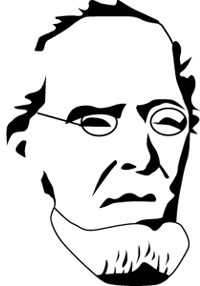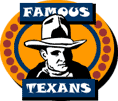

|


![]()
As an American philanthropist, businessman, and inventor, Gail Borden, Jr. envisioned food concentrates as a means of safeguarding the human food supply. He was the first to develop a commercial method of condensing milk, and the dairy company founded by him (renamed Borden, Inc., in 1968) expanded and diversified to become a sizable corporation operating in many areas of business.
Gail Borden, Jr. (1801-1874). Gail Borden, Jr., inventor, publisher, surveyor, and founder of the Borden Company, son of Gail and Philadelphia
Borden, was born in Norwich, New York, on November 9, 1801. In 1816 the family moved to New London, Indiana, where Borden obtained his only formal schooling, totaling not more than a year and a half. He is thought to have been captain of the local militia when barely twenty years old. In 1822 he was a principal figure in rescuing a freedman from rustlers. Shortly afterward he moved to Mississippi in search of a milder climate to cure a persistent cough. In Mississippi Borden surveyed and taught school. In 1826 he was official surveyor for Amite County as well as deputy federal surveyor.
After arriving at Galveston Island on December 24, 1829, he farmed and raised stock in upper Fort Bend County and spent some time in surveying. By February 1830 he had succeeded his brother, Thomas H. Borden, as surveyor for Stephen F. Austin's colony. In 1832 Borden was named one of three members of the San Felipe committee of correspondence. In the Convention of 1833 he represented Lavaca District . He also assumed many of the duties of colonial secretary for Austin in the absence of Samuel M. Williams.
As early as January 1835 Borden made plans to found a newspaper, but it was October 10 before the first issue of his Telegraph and Texas Register, published in partnership with his brother Thomas and Joseph Baker, appeared in San Felipe. In the meantime he had prepared the first topographical map of Texas and had resumed his responsibilities on the committee of correspondence. Borden published the Telegraph in San Felipe until March 1836, in Harrisburg in April 1836, in Columbia from August 1836 to April 1837, and in Houston in May and June 1837. In October 1835 he was appointed collector for the Department of Brazos, a post he held until 1837. In October and November 1836 he helped lay out the site of Houston.
On June 20, 1837, Borden sold his partnership in the Telegraph to Jacob W. Cruger and became the first collector of the port of Galveston under the Republic of Texas. His first term as collector lasted from June 1837 to December 1838, when Mirabeau B. Lamar removed him for political reasons. His second term lasted from December 1841 to April 1843; he resigned after a dispute with President Sam Houston over evaluation of exchequers.
From 1839 to 1851 Borden was secretary and agent for the Galveston City Company, which owned most of Galveston Island and for which he helped sell 2,500 lots. He invented a "locomotive bath house" for Galveston women who wished to bathe in the Gulf of Mexico. As an alderman he helped to rid the island temporarily of gamblers. He and his first wife reputedly became the first Anglo-Americans to be baptized in the Gulf west of the Mississippi River. He became Sunday school missionary to the poor and to travelers. He was a trustee of the Texas Baptist Education Society, which founded Baylor University. And he was an officer in the local temperance society and deacon and clerk of the local Baptist church. In 1842 Borden directed insular defenses against an expected Mexican invasion.
In the middle 1840s he began inventing. He is supposed to have experimented with large-scale refrigeration as a means of preventing yellow fever and with a terraqueous machine, a sort of prairie schooner that would go on land or water. In 1849 he perfected a meat biscuit, made of dehydrated meat compounded with flour, which he tried to market on a worldwide scale in partnership with Ashbel Smith. Although this project left him deeply in debt, for seven years Borden struggled to sell meat biscuits. For this purpose he moved to New York in 1851 to be nearer trade centers.
In 1853 he sought a patent on a process for condensing milk in vacuum, but it was 1856 before he received American and British patents. He then dropped the meat biscuit to devote himself to condensing milk. He opened a factory in Connecticut in 1856 but failed, then tried and failed again in 1857. Through Jeremiah Milbank, a New York financier, he received new backing and opened another factory in Connecticut in 1858. When the Civil War brought intensified demand for condensed milk, sales grew so much that Borden's success was assured. He opened another factory in Connecticut, two in New York, and one in Illinois and licensed other concerns in Pennsylvania and Maine. He also invented processes for condensing various fruit juices, for extract of beef, and for coffee. After the Civil War he established a meat-packing plant at Borden, Texas, twelve miles west of Columbus, and a sawmill and copperware factory at Bastrop.
After 1871 he spent his winters in Texas because of the milder climate. In 1873 he built a freedmen's school and a white children's school, organized a day school and a Sunday school for black children, aided in constructing five churches, maintained two missionaries, and partially supported numerous poorly paid teachers, ministers, and students. Borden married Penelope Mercer in Mississippi in 1828; they had seven children. In 1845 he married Augusta Stearns, and in 1860 he married Emeline Eunice Church. He died in Borden, Texas, on January 11, 1874; his body was shipped by private car to New York to be buried in Woodlawn Cemetery.
BIBLIOGRAPHY: Joe B. Frantz, Gail Borden: Dairyman to a Nation (Norman: University of Oklahoma Press, 1951). Hattie Borden Weld, Historical and Genealogical Record of the Borden Family (Los Angeles, 1899?). Clarence R. Wharton, Gail Borden, Pioneer (San Antonio: Naylor, 1941).
Joe B. Frantz
"BORDEN, GAIL, JR." The Handbook of Texas Online. <http://www.tshaonline.org/handbook/online/articles/view/BB/fbo24.html> [Accessed Fri Nov 3 12:20:36 US/Central 2000 ].